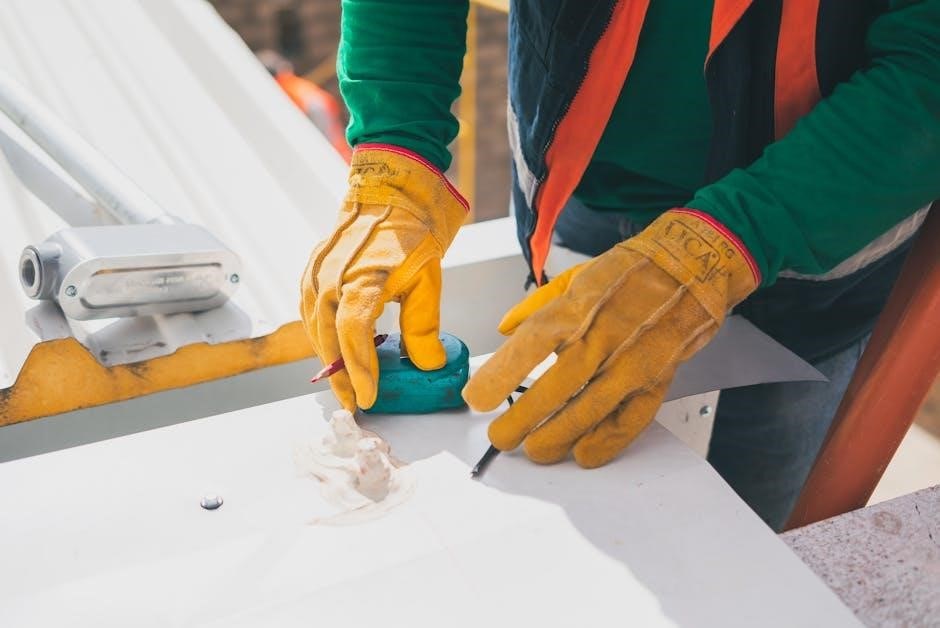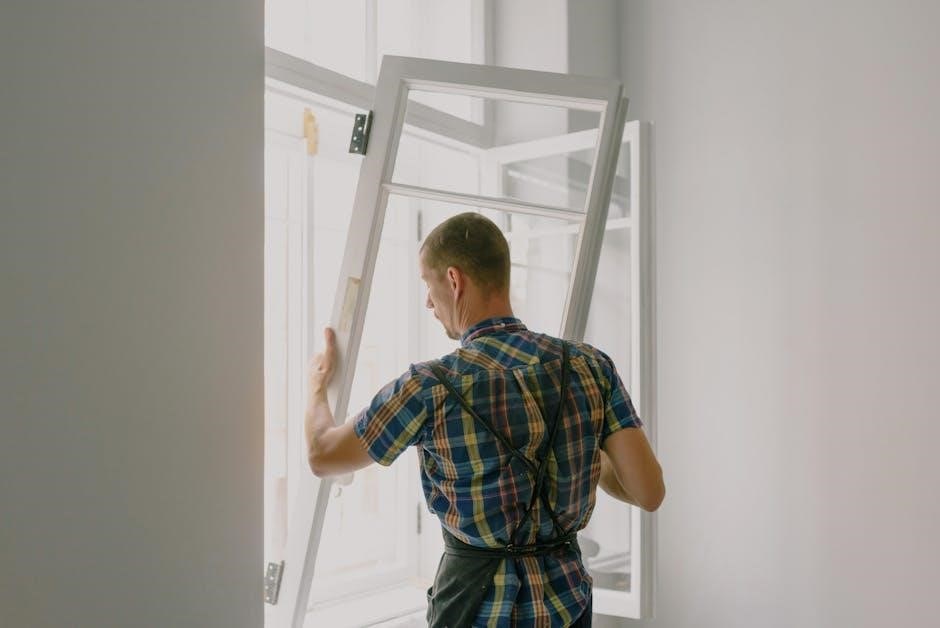The Bilstein 5100 shocks are a popular choice for trucks and SUVs, offering improved ride quality and handling. Designed for both on-road and off-road use, they provide exceptional durability and performance.

Overview of Bilstein 5100 Series
The Bilstein 5100 series is a line of high-performance shock absorbers designed for trucks and SUVs, offering enhanced ride quality and durability; These shocks are engineered to handle both on-road comfort and off-road challenges, making them a popular choice for drivers seeking versatility. With a focus on precision engineering, the Bilstein 5100 series provides superior damping control, reducing body roll and improving stability. They are compatible with a wide range of vehicles, including Ford F-150, Chevrolet Silverado, and GMC Canyon, among others. The shocks are assembled with vehicle-specific tuning, ensuring optimal performance for each application. Whether for daily driving or adventurous off-road excursions, the Bilstein 5100 series delivers consistent reliability and improved handling, making it a trusted upgrade for enthusiasts and professionals alike.
Key Features and Benefits
The Bilstein 5100 series offers exceptional performance, durability, and versatility for trucks and SUVs. These shocks are designed with high-quality materials and precise engineering to provide consistent damping control, reducing body roll and improving stability. One of their key benefits is their ability to adapt to both on-road comfort and off-road challenges, making them ideal for drivers who demand versatility. The shocks are tuned specifically for each vehicle, ensuring optimal performance and ride quality. They are also easy to install, with vehicle-specific instructions available. Additionally, the Bilstein 5100 series is known for its durability, withstanding harsh conditions and heavy use. Whether for daily commuting or adventurous off-road excursions, these shocks deliver enhanced handling, improved safety, and a smoother driving experience, making them a top choice for enthusiasts and professionals alike;
Vehicle Compatibility and Fitment
The Bilstein 5100 shocks are designed to fit a wide range of vehicles, including trucks and SUVs. They are particularly popular for models like the Ford F-150, Chevrolet Silverado, and GMC Canyon, with specific applications for both 2WD and 4WD configurations. The shocks are vehicle-specific, ensuring a precise fit and optimal performance. Before installation, it’s crucial to verify compatibility using the manufacturer’s fitment guide or online tools. Proper fitment ensures the shocks function as intended, providing improved ride quality and handling. Incorrect installation due to mismatched vehicles can lead to poor performance or safety issues. Always cross-reference the shock absorber part number with your vehicle’s make, model, and year to ensure a correct fit. This attention to detail guarantees a seamless installation and enhanced driving experience tailored to your specific vehicle needs.

Pre-Installation Preparation
Ensure you have the correct tools, such as a spring compressor and basic hand tools. Always lift the vehicle properly and loosen suspension nuts before disassembly. Consult the installation manual for specific preparation steps to guarantee a safe and successful process.
Tools and Equipment Required
Installing Bilstein 5100 shocks requires specific tools to ensure safety and accuracy. Essential tools include a spring compressor, impact wrench, torque wrench, and jack stands. Additional items like basic hand tools, such as wrenches and sockets, are necessary. A hydraulic jack is needed to lift the vehicle safely. Ensure all tools are in good condition to avoid complications. For strut assemblies, a specialized spring compressor is crucial to safely remove and reinstall the springs. Refer to the installation manual for a detailed list of required tools and equipment. Proper preparation ensures a smooth and efficient installation process, minimizing risks and ensuring optimal performance of the new shocks.
Safety Precautions and Guidelines
When installing Bilstein 5100 shocks, safety is paramount. Always wear protective gear, including gloves and safety glasses, to prevent injury. Ensure the vehicle is securely supported by jack stands and never rely solely on a jack. Disconnect the battery to avoid accidental startups. Follow the installation manual carefully, as improper steps can lead to system failure. Never tighten shock absorbers while the vehicle is on a lift with wheels hanging freely, as this can cause damage or unsafe conditions. Use a spring compressor when handling strut assemblies to prevent spring-related accidents. Keep loose clothing and long hair tied back to avoid entanglement with tools. Work in a well-ventilated area, away from open flames or sparks. After installation, test the vehicle in a controlled environment to ensure proper functionality and safety.
Understanding the Installation Manual
Understanding the Bilstein 5100 installation manual is crucial for a successful and safe installation. The manual provides detailed, vehicle-specific instructions, including diagrams and torque specifications. It outlines the correct tools and equipment needed, ensuring you’re prepared. Pay close attention to safety precautions, such as proper lifting techniques and spring compressor usage. The manual also covers hardware orientation, ensuring components are installed correctly. Follow the step-by-step guide to avoid common mistakes, like incorrect shock absorber orientation or improper tightening sequences. Refer to the manual for specific alignment and torque values, as these vary by vehicle. If unsure, consult online resources or manufacturer support. Properly understanding the manual ensures a smooth installation and optimal performance of your Bilstein 5100 shocks.

Installation Steps
Install Bilstein 5100 shocks by disassembling the strut, compressing springs, and replacing the absorber. Reassemble, tighten components, and test suspension performance for optimal ride quality and handling.
Front Shock Absorber Installation
Installing Bilstein 5100 front shocks requires careful preparation and attention to detail. Begin by raising the vehicle and removing the wheel for access. Use a spring compressor to safely compress the coil spring. Next, disconnect the stabilizer link and brake line from the strut assembly. Remove the mounting bolts and carefully pull the strut assembly away from the steering knuckle. Replace the old shock absorber with the new Bilstein 5100, ensuring proper orientation. Reassemble the strut, tightening all bolts in the correct sequence. Reconnect the stabilizer link and brake line, then decompress the spring. Finally, lower the vehicle and tighten all components to the specified torque values. Always follow the manufacturer’s instructions for a safe and successful installation.
Rear Shock Absorber Installation
Installing Bilstein 5100 rear shocks involves a systematic approach to ensure proper fitment and functionality. Begin by lifting the vehicle and supporting it with jack stands for safety. Remove the rear wheels and locate the shock absorber. Disconnect the shock from the mounting points, starting with the lower bolt and then the upper nut. Carefully pull the old shock absorber out and inspect the area for any debris. Mount the new Bilstein 5100 shock, ensuring it is correctly oriented and aligned with the mounting points. Reattach the shock by tightening the upper nut and lower bolt in the specified sequence. Reinstall the rear wheels and lower the vehicle to the ground. Tighten all bolts to the manufacturer’s recommended torque specifications. Always refer to the installation manual for specific instructions tailored to your vehicle.
Disassembling the Strut Assembly
Disassembling the strut assembly is a critical step when installing Bilstein 5100 shocks. Begin by removing the strut from the vehicle, ensuring it is securely held to prevent spring compression release. Use a spring compressor to safely compress the spring and remove the upper mount nut. Once the nut is removed, carefully lift the spring and isolate it from the strut assembly. Next, remove the lower bolt that secures the strut to the steering knuckle or axle. This allows the strut to be separated from the vehicle’s suspension components. Handle all components with care to avoid damage. If the strut is equipped with electronic damping, disconnect the electrical connectors before disassembling. Always refer to the installation manual for specific instructions, as procedures may vary depending on the vehicle make and model. Proper disassembly ensures a smooth and safe installation process for the new Bilstein 5100 shocks.
Installing the New Bilstein 5100 Shock
Installing the new Bilstein 5100 shock requires careful attention to detail to ensure proper function and safety. Begin by placing the shock absorber into the strut assembly, ensuring it is correctly oriented as specified in the installation manual. The piston rod should face upward, and the shock must be fully seated within the strut tube. Reattach the spring, making sure it is properly aligned and seated. Use a spring compressor to hold the spring in place while reassembling. Once the spring is secure, reinstall the upper mount and tighten the nut according to the manufacturer’s torque specifications. Finally, reattach the lower bolt to the steering knuckle or axle, ensuring it is tightened to the recommended torque. Double-check all connections and ensure the shock absorber is properly aligned before moving on to the next steps. Always refer to the manual for specific instructions tailored to your vehicle.
Reassembling the Strut Assembly
Reassembling the strut assembly is a critical step in the Bilstein 5100 shock installation process. Begin by carefully sliding the strut assembly back into the vehicle, ensuring it aligns properly with the steering knuckle and spring seat. Reattach the upper mount to the vehicle’s frame using the original hardware, tightening the bolts in a star pattern to avoid uneven pressure. Once the upper mount is secure, reconnect the lower bolt to the steering knuckle or axle, ensuring it is tightened to the manufacturer’s specified torque. Reinstall the spring, making sure it is properly seated and aligned. Use a spring compressor to hold the spring in place while tightening the upper nut. Double-check all connections and ensure the strut assembly is correctly oriented and securely fastened. Proper alignment and torque are essential for optimal performance and safety.

Tightening the Shock Absorbers
Tightening the Bilstein 5100 shock absorbers is a crucial step to ensure proper function and safety. Always tighten the shocks after the vehicle has been lowered to the ground, as this ensures the suspension is under load. Use a torque wrench to tighten the upper and lower mounting bolts to the manufacturer’s specified torque values, which can be found in the installation manual. Start with the upper bolt, tightening it in a star pattern to avoid uneven pressure on the mount. Next, tighten the lower bolt, ensuring it is securely fastened to the axle or steering knuckle. Double-check all connections to confirm they are properly aligned and tightened. Improper tightening can lead to reduced performance or safety hazards, so precision is key. Refer to the provided instructions for exact torque specifications and tightening sequences.
Post-Installation Checks
After installing Bilstein 5100 shocks, test the vehicle’s suspension by driving on various surfaces to ensure smooth handling and proper absorption of bumps. Check for any leaks, unusual noises, or vibrations. Verify that all bolts and nuts are tightened to the recommended torque specifications. Inspect the alignment to ensure it matches the manufacturer’s guidelines. A test drive is essential to confirm the shocks are functioning correctly and providing the expected ride quality improvements. Address any issues promptly to maintain safety and performance.

Testing the Vehicle’s Suspension

After installing the Bilstein 5100 shocks, conduct a thorough test drive to assess the suspension’s performance. Drive on various surfaces, including smooth roads, bumps, and uneven terrain, to ensure the shocks absorb impacts effectively. Listen for any unusual noises or vibrations, which could indicate improper installation or component damage. Check for leaks around the shock absorbers, as this could signify a faulty seal. Pay attention to how the vehicle handles corners and braking, ensuring stability and control. If the vehicle bottoms out frequently, it may require further adjustment or inspection. A proper test drive helps verify that the shocks are functioning as intended and provides a baseline for future performance comparisons. Address any issues promptly to maintain optimal ride quality and safety.
Ensuring Proper Alignment
After installing the Bilstein 5100 shocks, it’s crucial to ensure proper wheel alignment to maintain optimal vehicle performance and safety. Misalignment can lead to uneven tire wear, poor handling, and reduced stability. Take the vehicle to a professional alignment shop or use specialized tools to check and adjust the alignment. Refer to the vehicle’s manufacturer specifications for correct camber, caster, and toe settings. Ensure the vehicle is loaded as it would be under normal driving conditions during the alignment process. If the vehicle was lifted or modified, double-check the alignment to avoid issues like uneven tire wear or pulling to one side. Proper alignment ensures the shocks function as intended and provides a smooth, safe driving experience; Address any alignment issues promptly to maximize the performance and longevity of your Bilstein 5100 shocks.
Verifying Shock Absorber Functionality
After installation, it’s essential to verify the functionality of the Bilstein 5100 shocks to ensure they perform as expected. Start by driving the vehicle on a smooth road to assess ride quality and handling. Check for any unusual noises, such as clunking or hissing, which could indicate improper installation or damage. Inspect the shocks for signs of leaks or physical damage. Test the vehicle’s suspension by driving over bumps or uneven terrain to ensure the shocks absorb impacts effectively. If the vehicle bottoms out or rides harshly, it may indicate a problem with the shocks or their installation. Additionally, perform a bounce test by pressing down on the vehicle’s bumper and releasing it to see if it returns to its normal position smoothly. If any issues arise, consult a professional mechanic or refer to the installation manual for troubleshooting guidance.
Troubleshooting Common Issues
Troubleshooting common issues with Bilstein 5100 shocks involves addressing problems like vehicle bottoming out, incorrect shock orientation, or hardware-related faults. Always consult the installation manual or seek professional assistance for unresolved issues.
Vehicle Bottoming Out After Installation
Vehicle bottoming out after installing Bilstein 5100 shocks can occur due to incorrect installation or improper setup. This issue often arises when the shocks are not torqued correctly or if the spring seats are misaligned. Ensure all hardware is tightened according to the manufacturer’s specifications. If the problem persists, check the shock absorber orientation and verify that the vehicle’s weight is evenly distributed. In some cases, bottoming out may indicate the need for additional suspension modifications or adjustments. Always refer to the installation manual for guidance, and consider consulting a professional if the issue remains unresolved. Proper alignment and torque specifications are critical to preventing this common post-installation problem.
Incorrect Shock Absorber Orientation
Incorrect shock absorber orientation is a common issue that can lead to poor performance and potential damage to the suspension system. Bilstein 5100 shocks must be installed with the correct orientation to ensure proper function. Misalignment can cause uneven wear, reduced damping efficiency, and even premature failure of the shock absorber. Always refer to the installation manual for specific orientation guidelines, as incorrect mounting can void the warranty. Ensure the shock absorber is installed with the piston rod facing downward and the reservoir (if applicable) properly positioned. If unsure, consult a professional or use alignment tools to verify correct placement. Proper orientation is critical for maintaining the vehicle’s stability and handling, especially under varying road conditions. Double-checking the orientation during installation can prevent future issues and ensure optimal performance from your Bilstein 5100 shocks.

Hardware and Tool-Related Problems
Hardware and tool-related issues can arise during the installation of Bilstein 5100 shocks, potentially causing delays or improper fitment. Common problems include using incorrect tools, such as wrenches or sockets that do not fit properly, which can damage the shock absorber or suspension components. Misaligned or missing hardware, such as bolts or washers, can also lead to improper installation. Additionally, using the wrong spring compressor or failing to tighten components in the correct order can result in unsafe conditions. Always ensure all tools and hardware are compatible with your vehicle and the Bilstein 5100 shocks. Refer to the installation manual for specific tool requirements and hardware specifications. If unsure, consult a professional mechanic to avoid complications. Proper tool usage and hardware alignment are critical for a safe and successful installation.

Maintenance and Upkeep
Regular inspection of Bilstein 5100 shocks ensures optimal performance. Clean and lubricate components to prevent corrosion and wear. Check for leaks or damage and address issues promptly;
Regular Inspection of Shocks
Regular inspection of Bilstein 5100 shocks is crucial for maintaining optimal performance and safety. Start by visually examining the shock absorbers for signs of leaks, dents, or rust. Check the mounting hardware for looseness or corrosion, ensuring all bolts and nuts are securely tightened. Inspect the bushings and seals for wear or damage, as these components are vital for proper function. Look for any abnormal noises during operation, such as clunking or hissing, which may indicate internal damage. Additionally, test the vehicle’s suspension by driving over bumps to assess the shocks’ responsiveness. Regular cleaning of the shock bodies and surrounding areas can prevent dirt buildup and corrosion. Address any issues promptly to avoid premature wear and ensure the shocks continue to provide the desired ride quality and handling.
Cleaning and Lubricating Components
Cleaning and lubricating the Bilstein 5100 shocks and related components are essential for maintaining their performance and longevity. Start by wiping down the shock absorbers with a soft cloth or brush to remove dirt, dust, or debris. Avoid using high-pressure washes or harsh chemicals, as they may damage the finishes or seals. For stubborn grime, mix mild soap with warm water and gently scrub the shock bodies. After cleaning, apply a silicone-based lubricant to moving parts, such as the bushings and mounting hardware, to reduce friction and prevent corrosion. Regular lubrication ensures smooth operation and helps maintain the shocks’ responsiveness. Clean and lubricate the components every 6 to 12 months or after exposure to harsh conditions like mud or salt. This routine maintenance will help preserve the shocks’ functionality and overall vehicle performance.
When to Replace Shocks
Determining when to replace Bilstein 5100 shocks is crucial for maintaining optimal vehicle performance and safety. Signs of worn-out shocks include excessive bouncing, swaying, or a “bottoming out” sensation when driving over bumps. If the shocks show physical damage, such as dented bodies or leaking fluid, they should be replaced immediately. Additionally, if the vehicle’s handling becomes unstable or the ride quality deteriorates significantly, it may indicate failing shocks. Manufacturers recommend replacing shocks every 50,000 to 100,000 miles, depending on usage and driving conditions. For vehicles frequently driven off-road or in harsh environments, more frequent inspections and replacements may be necessary. Always consult a professional if unsure about the condition of your Bilstein 5100 shocks to ensure proper functionality and safety on the road.
Additional Resources
For Bilstein 5100 installation, access online guides, manufacturer support, and community forums for detailed instructions, troubleshooting, and expert advice.
Online Installation Guides and Videos

Online resources provide comprehensive guides and videos for Bilstein 5100 shock installations. Detailed step-by-step instructions, including safety precautions and hardware orientation, are available in Bilstein’s online catalog. Videos demonstrate installations on specific vehicles, such as the 2019 GMC Canyon, showcasing the process. These resources cover disassembling strut assemblies, spring compressor usage, and proper shock absorber tightening. Troubleshooting tips, like addressing bottoming out issues, are also included. Manufacturer websites and forums offer additional support, ensuring a smooth installation experience. These materials are designed to help users achieve professional results, whether on-road or off-road, aligning with Bilstein’s commitment to performance and durability.
Manufacturer Support and Warranty
Bilstein offers robust manufacturer support, including a limited warranty for the 5100 series shocks. With over 60 years of experience, Bilstein ensures high-quality products and reliable customer service. Their online catalog provides easy access to installation instructions, part compatibility, and warranty details. The warranty covers defects in materials and workmanship, offering peace of mind for users. Bilstein’s dedicated support team is available to address installation queries and troubleshooting. Additionally, their extensive racing and OEM experience underscores their commitment to durability and performance. Customers can rely on Bilstein’s comprehensive support system to resolve any issues, ensuring a seamless installation and ownership experience for their 5100 shocks.
Community Forums and Expert Advice
Community forums and expert advice play a crucial role in simplifying the installation process of Bilstein 5100 shocks. Enthusiast communities share real-world experiences, offering tips on troubleshooting common issues like vehicle bottoming out or incorrect shock orientation. Videos, such as one detailing the installation on a 2019 GMC Canyon, provide visual guidance. Experts often emphasize proper tools and safety precautions, while forums allow users to ask specific questions. These resources complement official instructions, offering practical insights and solutions. By engaging with these communities, installers can gain confidence and avoid pitfalls, ensuring a successful setup. Such collaborative support enhances the overall experience of upgrading with Bilstein 5100 shocks.
